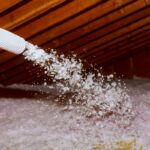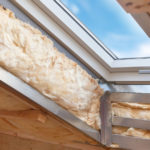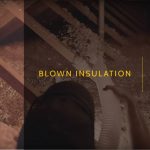At some point in their lives, most people have probably heard a mom or dad yell, “Close the front door! We’re not trying to heat the whole neighborhood!”
Everyone wants to keep their home appropriately warm during the winter and cool during the summer without spending a fortune to do so. In this scenario, the door represents the basic principle of how insulation works, acting as a barrier that helps seal warm or cool air inside where it belongs. Making sure your house has adequate insulation is the crucial factor in achieving that goal.
Like water, air seeks to balance itself by acclimating to its surroundings, much like an ice cube will melt if the air around it is above freezing. Let’s say the air in your home is 40 degrees warmer than the exterior temperature. Without any insulation for resistance, the warm air will seep out of your house trying to equalize with the colder air outside.
What is insulation?
In simplest terms, insulation is material that’s placed into your home’s walls, floors, attics and ceilings to prevent the heated or cooled air inside from leaking out. (It also absorbs sound, reducing noise between rooms and spaces.) Good insulation helps your HVAC system operate more efficiently — you’re already paying for the energy to heat or cool your home; insulation ensures the effect lasts as long as possible. If you don’t have decent insulation, the warm or cool air your HVAC system is working so hard to generate dissipates much more quickly, costing you money and personal comfort.
Modern insulation is made from fiberglass and sold in batted sheets that can be cut to size, rolled into joists and stapled into place; or as loose bagged cellulose that can be spot-blown into spaces using equipment specific to this purpose. Most insulation usually costs somewhere in the range of $1 to $2 per square foot.
Insulation is measured by R-value, a number between 1 and 60 that rates the material’s resistance to heat and air flow based on its thickness and density. The higher the R-value, the better the insulation will perform. A product with higher R-value will cost more than a product with lower R-value, but in colder regions of the country, the added upfront expense may prove well worth it in terms of heat preservation and savings on utility bills over time. Homeowners who live in more moderate climates probably won’t need insulation of the same R-value level as those in areas with harsh winters. Helpful charts of recommended R-values by geographic region are readily available online for quick reference.
How do you know if your home has enough insulation?
You can measure the insulation in your home with a ruler and research the suggested R-value for your region to determine if you have what you need in place. Most homes should have at least 12 inches of insulation with no obvious gaps. If there’s any question as to whether or not you have the right amount, err on the side of excess. It’s better to have too much insulation than not enough. It’s also important to note that the U.S. Department of Energy updated its R-value recommendations just last year, so if your house was built prior to 2017, it’s likely to need more insulation.
Homeowners can choose to purchase insulation at home retail stores and install it themselves or hire a professional contractor. It’s fairly easy to roll and staple batted insulation into place, although this option can create gaps. Blowing in cellulose fills spaces more completely, but the process can be a bit more complicated, not to mention messy. Plus, you’ll have to rent the proper equipment and learn how to use it correctly and safely. The advantages of relying on the professionals to install your insulation lie in the assurance that they have the experience and the tools to get the job done right the first time.
Once it’s in place, good insulation should last for years. The fiberglass material won’t break down over time and shouldn’t require revisiting unless R-value recommendations change or it gets damaged by rodents or birds.








